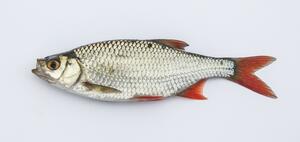Rudd
Rudd Scardinius erythrophthalmus
Where do rudd come from?
- The rudd is a Eurasian native.
- The rudd was introduced into the U.S. in the early 1900s as a baitfish.
- The rudd has been found in Wilson Reservoir, (Neosho River drainage) and a farm pond near Deep Creek (Kansas River drainage)
What do rudd look like?
- The rudd is similar in appearance to the golden shiner.
- They have a dark grey back, silver sides, blood-red fins (golden shiner fins are yellow)
- They can get up to 14 inches long.
Why is rudd a problem?
- They consume vegetation which can potentially impact spawning areas for other species.
- Rudd will hybridize with golden shiners.
How do rudd spread?
- Rudd were first introduced to North America for use as a baitfish.
- Rudd can be spread by anglers accidentally using them as bait.
How do we control the rudd?
- Learn to identify the rudd.
- Always drain water from your boat, livewell, and bilge before leaving any water access.
- Always dispose of your unwanted bait on land or in the trash.
- Never dip your bait bucket into a lake or river if it has water in it from another waterbody.
Never dump live fish from one waterbody into another.
What do I do if I find a rudd?
- Do not release the fish back into the water. If you discover a rudd, freeze it in a sealed plastic bag, note the date and location, and call the Emporia Research Office at (620) 342-0658 or email the Aquatic Nuisance Species Coordinator. Early detection of isolated populations may help prevent their spread. Your help to report new sightings and to prevent their spread is vital.
Images and Recent news
Rudd links:










